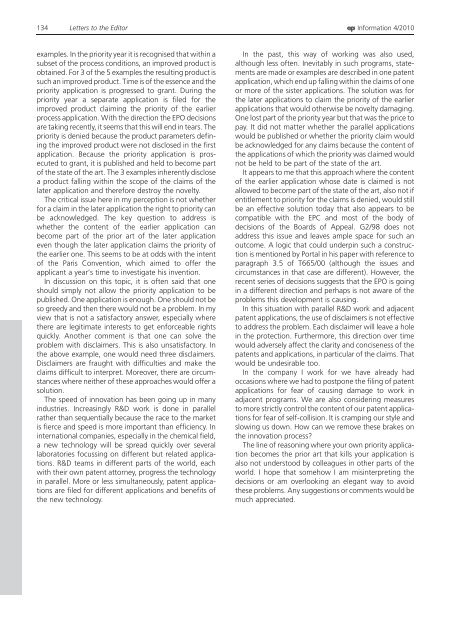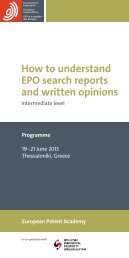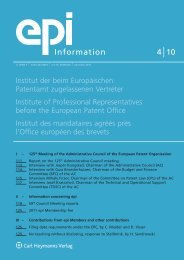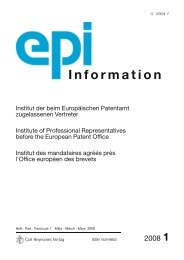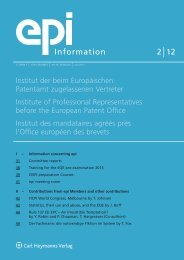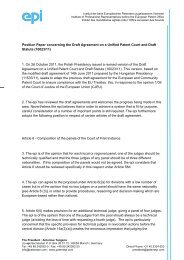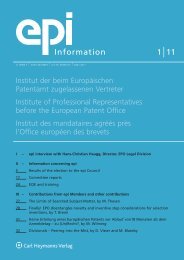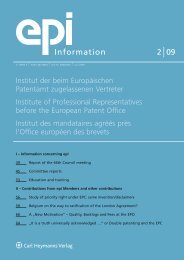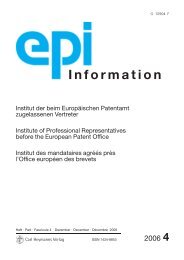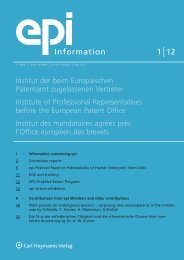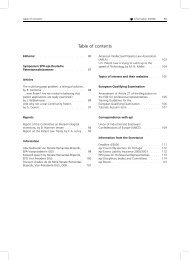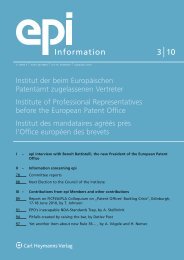4 10 Information - European Patent Institute
4 10 Information - European Patent Institute
4 10 Information - European Patent Institute
Create successful ePaper yourself
Turn your PDF publications into a flip-book with our unique Google optimized e-Paper software.
134 Letters to the Editor <strong>Information</strong> 4/20<strong>10</strong><br />
examples. In the priority year it is recognised that within a<br />
subset of the process conditions, an improved product is<br />
obtained. For 3 of the 5 examples the resulting product is<br />
such an improved product. Time is of the essence and the<br />
priority application is progressed to grant. During the<br />
priority year a separate application is filed for the<br />
improved product claiming the priority of the earlier<br />
process application. With the direction the EPO decisions<br />
are taking recently, it seems that this will end in tears. The<br />
priority is denied because the product parameters defining<br />
the improved product were not disclosed in the first<br />
application. Because the priority application is prosecuted<br />
to grant, it is published and held to become part<br />
of the state of the art. The 3 examples inherently disclose<br />
a product falling within the scope of the claims of the<br />
later application and therefore destroy the novelty.<br />
The critical issue here in my perception is not whether<br />
for a claim in the later application the right to priority can<br />
be acknowledged. The key question to address is<br />
whether the content of the earlier application can<br />
become part of the prior art of the later application<br />
even though the later application claims the priority of<br />
the earlier one. This seems to be at odds with the intent<br />
of the Paris Convention, which aimed to offer the<br />
applicant a year’s time to investigate his invention.<br />
In discussion on this topic, it is often said that one<br />
should simply not allow the priority application to be<br />
published. One application is enough. One should not be<br />
so greedy and then there would not be a problem. In my<br />
view that is not a satisfactory answer, especially where<br />
there are legitimate interests to get enforceable rights<br />
quickly. Another comment is that one can solve the<br />
problem with disclaimers. This is also unsatisfactory. In<br />
the above example, one would need three disclaimers.<br />
Disclaimers are fraught with difficulties and make the<br />
claims difficult to interpret. Moreover, there are circumstances<br />
where neither of these approaches would offer a<br />
solution.<br />
The speed of innovation has been going up in many<br />
industries. Increasingly R&D work is done in parallel<br />
rather than sequentially because the race to the market<br />
is fierce and speed is more important than efficiency. In<br />
international companies, especially in the chemical field,<br />
a new technology will be spread quickly over several<br />
laboratories focussing on different but related applications.<br />
R&D teams in different parts of the world, each<br />
with their own patent attorney, progress the technology<br />
in parallel. More or less simultaneously, patent applications<br />
are filed for different applications and benefits of<br />
the new technology.<br />
In the past, this way of working was also used,<br />
although less often. Inevitably in such programs, statements<br />
are made or examples are described in one patent<br />
application, which end up falling within the claims of one<br />
or more of the sister applications. The solution was for<br />
the later applications to claim the priority of the earlier<br />
applications that would otherwise be novelty damaging.<br />
One lost part of the priority year but that was the price to<br />
pay. It did not matter whether the parallel applications<br />
would be published or whether the priority claim would<br />
be acknowledged for any claims because the content of<br />
the applications of which the priority was claimed would<br />
not be held to be part of the state of the art.<br />
It appears to me that this approach where the content<br />
of the earlier application whose date is claimed is not<br />
allowed to become part of the state of the art, also not if<br />
entitlement to priority for the claims is denied, would still<br />
be an effective solution today that also appears to be<br />
compatible with the EPC and most of the body of<br />
decisions of the Boards of Appeal. G2/98 does not<br />
address this issue and leaves ample space for such an<br />
outcome. A logic that could underpin such a construction<br />
is mentioned by Portal in his paper with reference to<br />
paragraph 3.5 of T665/00 (although the issues and<br />
circumstances in that case are different). However, the<br />
recent series of decisions suggests that the EPO is going<br />
in a different direction and perhaps is not aware of the<br />
problems this development is causing.<br />
In this situation with parallel R&D work and adjacent<br />
patent applications, the use of disclaimers is not effective<br />
to address the problem. Each disclaimer will leave a hole<br />
in the protection. Furthermore, this direction over time<br />
would adversely affect the clarity and conciseness of the<br />
patents and applications, in particular of the claims. That<br />
would be undesirable too.<br />
In the company I work for we have already had<br />
occasions where we had to postpone the filing of patent<br />
applications for fear of causing damage to work in<br />
adjacent programs. We are also considering measures<br />
to more strictly control the content of our patent applications<br />
for fear of self-collision. It is cramping our style and<br />
slowing us down. How can we remove these brakes on<br />
the innovation process?<br />
The line of reasoning where your own priority application<br />
becomes the prior art that kills your application is<br />
also not understood by colleagues in other parts of the<br />
world. I hope that somehow I am misinterpreting the<br />
decisions or am overlooking an elegant way to avoid<br />
these problems. Any suggestions or comments would be<br />
much appreciated.


